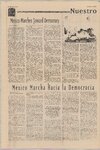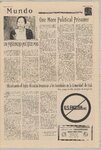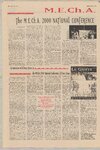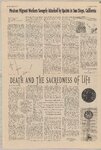| OCR Text |
Show 3 6 VENCEREMOS SUMMER M.E.Ch 2000 ]he M.E.Ch.A. 2000 NATIONAL CONFERENCE that was founded during the Chicano civil rights movement of the 60s and 70s. It is based on El Plan de Santa By Teresa Hughes The sound of hands clapping rises like thunder in the gymnasium at El Paso Community College. As the rhythm of the clapping quickens it 18 joied by cries of “Chicano power!” and “Que viva lá Raza!” This ais a regular occurrence at the national conference of the Movimiento Estudiantil Chicana/o de Aztlan, or Barbara, a philosophical document created by Chicanas/os at a conference in Santa Barbara, Califas. As the name implies, MECHA is a student based organization whose purpose 1s to empower the Chicano community socially, politically, cducationally, cconomically and spiritually. The definition of the term Chi- MECHA. : Each year hundreds of university and high school students from around the country take part in the cana/o, which national They given a clear definition. It states, "We come togcther for a few days to celebrate and learn morc about their heritage, make decisions about political as MEChistAs see the process of Chi- action MECHA conference. to be taken, and to socialize with other students like themsclves. Thc conference is hosted by the MECHA chapter of onc college or university in the United States. This chapter puts together a theme for the conference along with an itincrary for workshops, guest speakers, and social events. : Thc Movimiento Estudiantil Chi- is part of the name of the oganization, is a vital to MECHAS philosophy. In MECHhA's philosophy documents this term 1s canismo as evolutionary. We recog- nizc that no onc is born politically Chicana or Chicano. Chicanismo results fom a decision based on a political consciousness. Thercfore, the term Chicano is grounded in a philosophy, not a nationality. Chicanismo does not cxclude anyonc, rather, it includes those who acknowledge and work toward the betterment of La Raza.” There are hundccds of MEChA translates to chapters in colleges, universities, and the Chicana/o Student Movement of Aztlan, is a national o high schools across the nation that makc up po regions. Each chapter cana/o de Aztlan, which and region meets regularly throughout the year to educate themselves, socialize, and most importantly, take political action to empower themselves and the Chicano community. This year's conference was held April 20-23 at El Paso Community College .in El: Paso, Texas. +. .Lhe theme, “El Paso Evolucionario: Tierra, Libertad, y Solidaridad,” was used to provide focus on the concept of Aztlan and its spiritual, ideological, political and physical nature. Aztlan is an important concept in MECHAS philosophy. Aztlan 1s generally believed to be the original homeland of the Mexicas or Áztecs located im what 1s now called the southwest United States. It also refers to a philosophy or ideology involving spiritual and political empowerment. To bring attention to this theme, workshops focused on research being done on the physical location of Aztlan, its spiritual meaning, and issues affecting the Chicana/o community living in present day Aztlan. These issues ranged from Chicanas/os reaching higher educational goals, to the WTO protests in Seattle, to police brutality, to indigenous traditions and beliefs. un a E Ds 5NN (O (As 922 22 MM Oña - resent urin! tne : amandante The keynote? E 5 O ashateria, olura | a EEN | ] - the nas 2000 Nate de Ñ asa, Tens.) | A Henry Perez is the Editor in Chief of LA. GENTE: DE AZTLAN, University of California Los Angeles. Marcial: Henry, what made you get involved with LA GENTE DE AZTLAN publication? Perez: Pretty much since I came onto the UCLA campus I was introduced to LA GENTE DE AZTLAN news magazine. The Gente de Aztlan contributed greatly in the development of my political conscious. lt was an educational tool that many people, including myself, used to learn about the issues of the Chicana/o community, and it was something very powerful that 1 felt was important in empowering myself. Pretty much seeing the effects and the impacts that the news magazine had on its readership, in particular in the Chicano/Latina leadership, played a major role in my desire and my motivation to become involved with the magazine. I want to continue the progressive direction of LA GENTE DE AZTLAN magazine. Covering issues that don't necessarily receive the attention that they deserve in mainstream media, LA GENTE DE AZTLAN magazine provides a forum for progressive issues to be discussed, and to me that is empowering. Marcial: Is LA GENTE DE GENTE a nationalist magazine that deals with only Chicano/Mexicano issues or 1s 1t more inclusive. Does the maga“zine also deal with issues of other Latinos and working class communities. Perez: In answering that ques“tion we will need to define what “is Chicana/o. Chicana/o is defined in many different ways. For me Chicana/o is not necessarily tied to a nationality or to an ethnicity it is more of an identity. A self identity or political idenciey that people take on as a form of resistance to many names that are often imposed on us. I think the term or the identity of being Chicana/o 1s inclusive. It is inclusive of everybody who wishes to identify in the struggle of the Chicano Movement. In that sense 1t is an inclusive term and leads to an nity in “something that is very rewarding and empowering. We definitely bring in professors as well. Professors that have progressive ideologies that they can put their work and points of view and perspectives in our magazine. These academic scholars, and community scholars have very important perspective and points inclusive identity, not anything of views that our community can benefit from in being part of LA that is exclusive to anything but Mexican Americans. GENTE DE AZELAN: Marcial: How does LA GENTE Marcial: How does a publicaDE AZTLAN promote a unified tion like LA GENTE DE AZTfront as far as the Chicano MoveLAN provoke thought and communication ment. Perez: I think by There is definitely a need With OS being a forum for for us to createfi an o reads it. diverse topics to be discussed through opportunity Or Ectez We progressive journalism.' strive to be our magazine we in that sense are 4 For us to an interacunifying tool for news create that forum for the tive our community. magazine. We try to focus on issues of our community The input of to be addressed. a wide range of our readerissues that range ship is from educational issues, political extremely important. For that issues, labor issues, throughout reason we have developed sections the Americas. In that sense we are focused on incorporating our readership into our magazine. We a very unifying media for our community. We've been around have letters to the editor where since 1971. Since then we covered we get a lot of ideas from our Native American issues, student readership in what they enjoy organizing,the struggle for Chiabout our news magazine and cana/o studies as well as several what we can improve on in our propositions ranging from proponews magazine. We also have a sitions 184, 187,209, 21, 22, and section called “En Tus Palabras” 227.We address a wide range of which translates “In Your Own issues to educate our readership. Words,” where people in our Marcial: Is LA GENTE DE community give their points of view and perspectives on what we AZTLAN news magazine a recruitment and retention tool as call hot issues at that time. Our far as students, faculty, and staff? readership can talk about police Perez: Yes we have a huge staff brutality and what they personalthat gets involved in so many difly feel about police brutality. ferent aspects of the magazine. What they feel about militarizaCoordinating the magazine is a tion of the border and what they huge task and there are many diffeel about the elimination of affirferent aspects to it, and plugging mative action; these type of issues that our community often does people into those aspects is a wonderful way to include our communot get an opportunity to voice. a a play E col Sarah Hunt, a MEChistA at the University of Utah who attended several workshops by Gonzales and Rodriguez, said that the theory of Aztlan being located in the Salt Lake Valley was an interesting” one, although she personally felt that more physical proof was needed. “It's something to think about. It provides a common story that helps to strengthen the group, which is good,” Hunt said. The national conference provided each region with the chance to meet several times. They were able to discuss issues of concern within their own regions and on a national level. has shown that Aztlan, which was Resolutions proposed at the conferonce believed to be in northeast Mexence were discussed and voted on ico, was actually located within the See NATIONALS on Page 7 Salt Lake Valley. Noc speakers of e conference were Patrisia Gonzales and Roberto Rodriguez, Chicano journalists currently researching the location of Aztlan. They have spent much of the past year studying old documents and maps on the southwest United States. Gonzales and Rodriguez have also spent time speaking with Native peoples of the southwest to learn more about their oral traditions. They believe that these oral traditions will give them more insight into the location of Aztlan since they tell of the people who have imhabited the southwest. Their research so far An Interview with Henry perez dl s A 3 ( Sh o-3 na den PUEBLOS Another section that we have i “Expressiones.” That is our cre ative Writing: section where we: have a call fo creative writing from our reader ship so they can contribute and *: see their work: published in our: magazine. Thei work should b honored and val ued, but unfor tunately 1t 1sn' in mainstream media. We pay attention to the underground, artists, poets, music, and creative writers. We give them that opportunity to submit their work and have it published in our magazine where otherwise mainstream media would not even consider them. It is work that is very creative and positive for our community, but unfortunately mainstream media does not view itthat way Marcial: The MECHA conference, what did you gain? Perez: Anytime a large group of people from all the nation get together ina common cause it is a very empowering event and that is what the MEChA National Conference is about. It gives us an opportunityas MEChistAs from all over the nation to come together and interact with each other and become familiar with the issues that pretty much plague our communities on a national level and even at an international level. 1 try to find solutions to those issues and try to engage in keeping the movement going; that has been going for over 30 years. Now the challenge in the conference of this magni- T E a * E a A tude is remaining focused, mak- ing sure that the participates of this conference remain focused on the goals and objective of our organization, which is the empowerment of our Chicana/o community. Marcial: Thank you for the interview, is there anything else you want to add. Perez: There is definitely a need for us to create an opportunity for progressive journalism. For us to create that forum for the issues of our community to be addressed: In LA GENTE DE AZTLAN news magazine we do not promote complacency. Rather, we promote action and the unified action as the Chicana/o communi- ty and being critical people of issues in the institutions that for over 500 years have oppressed our communities. We strive to create solutions within ourselves towards the issues that continue to plague our communities for over 500 years. LA GENTE DE AZTLAN 118 Kerckhoff Hall 308 Westwood Plaza Los Angeles, Ca, 90024 lagente Omedia.ucla.edu |














